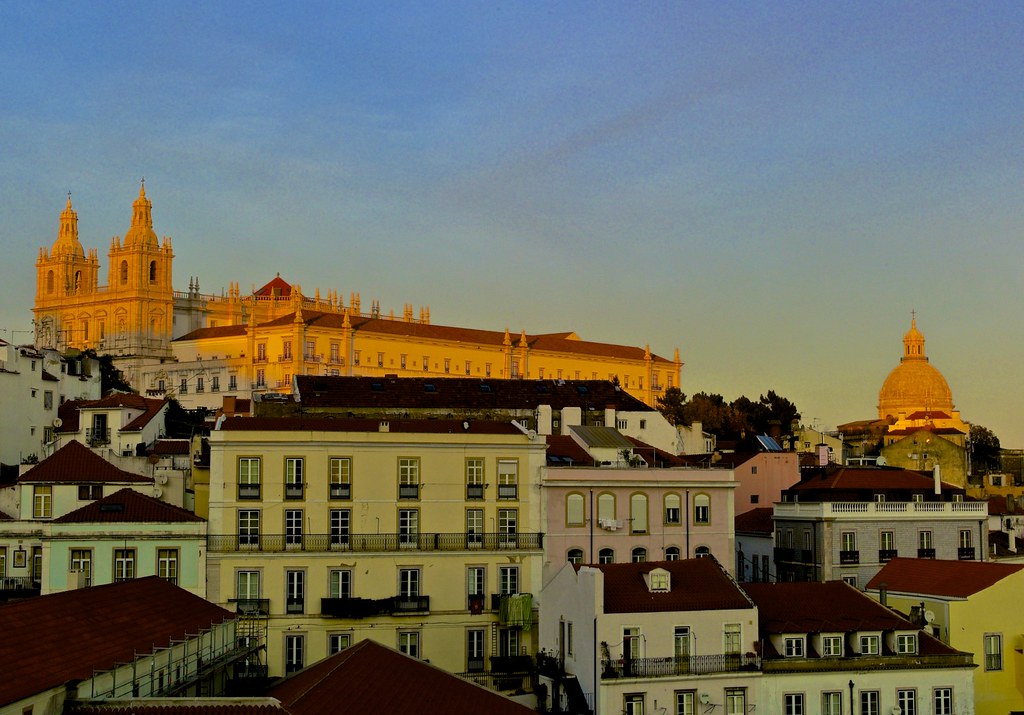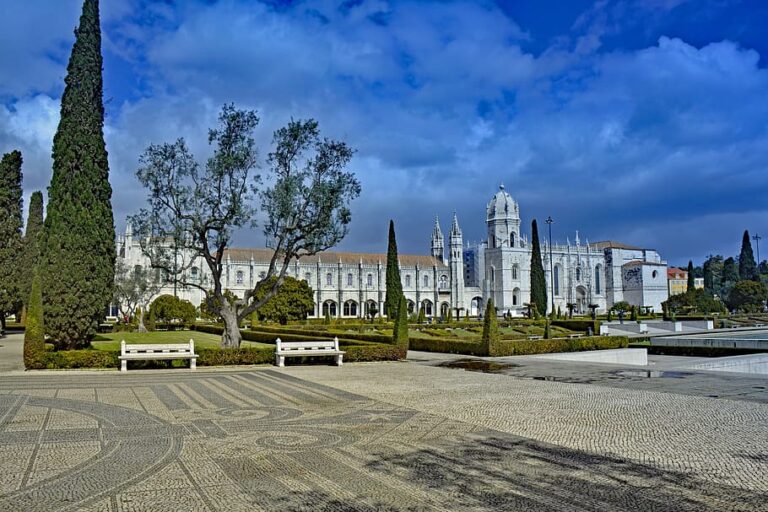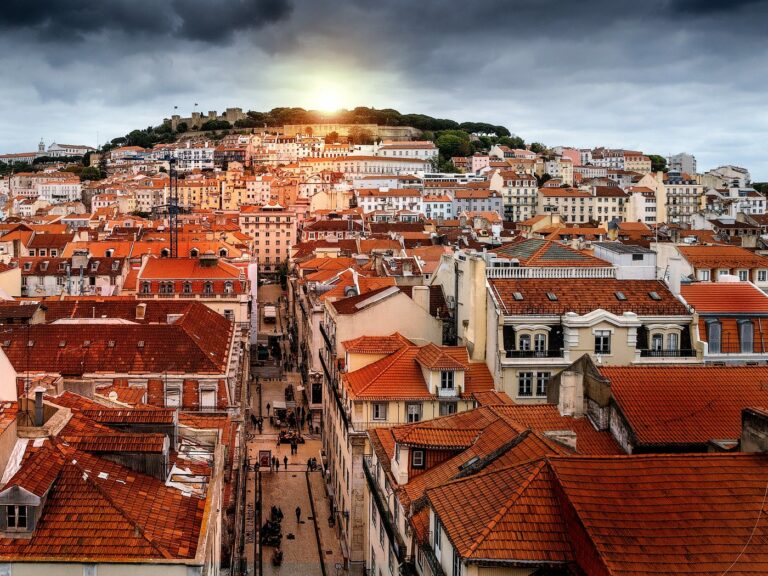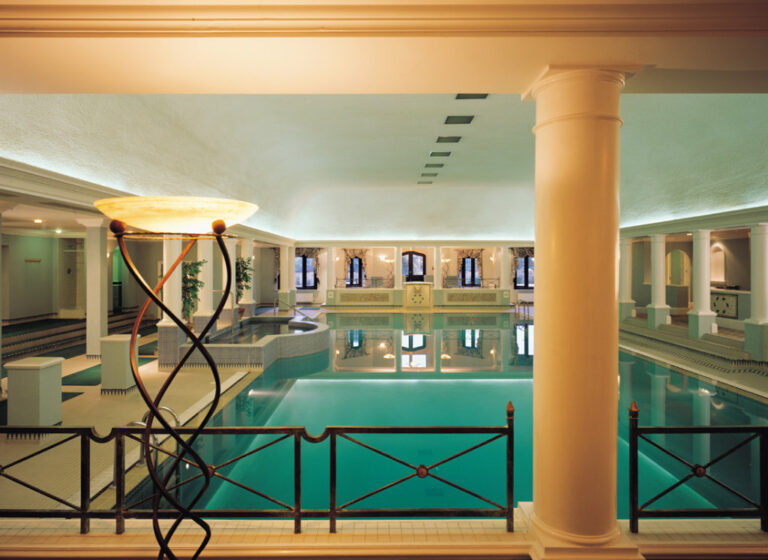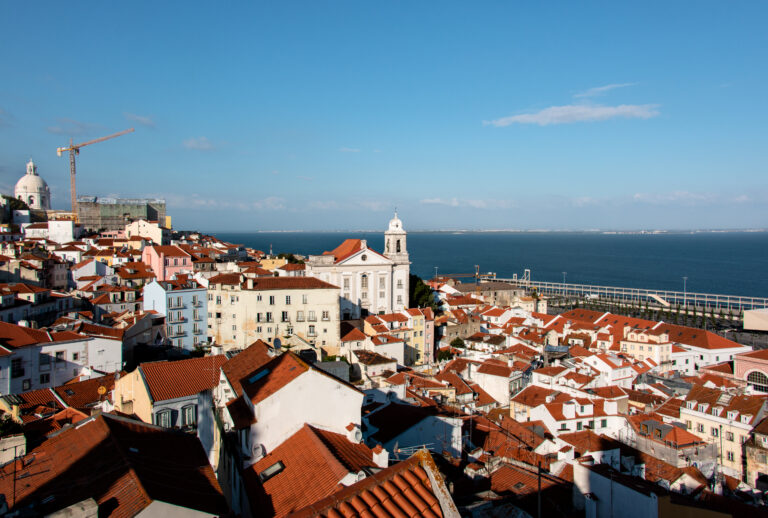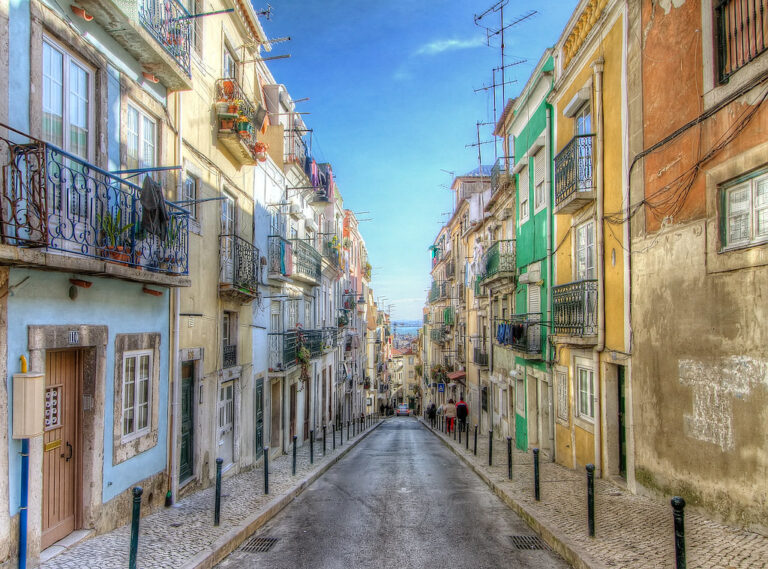When I first moved to Portugal, I lived in Alfama Lisbon, where I called home for the first few months.
Nestled amidst its picturesque streets and vibrant alleys, the historic district of Lisbon became more than just a residence—it became an immersive experience.
Picture this: cobbled streets, panoramic views, cozy corners, local cafes exuding warmth, and a taste of the extraordinary in every sip of orange juice. The oranges are not just citrusy delights but a testament to the region’s rich flavors.
So, if you plan a trip to Alfama, Lisbon, keep reading to learn about the oldest district.
Plan Your Trip to Alfama Lisbon
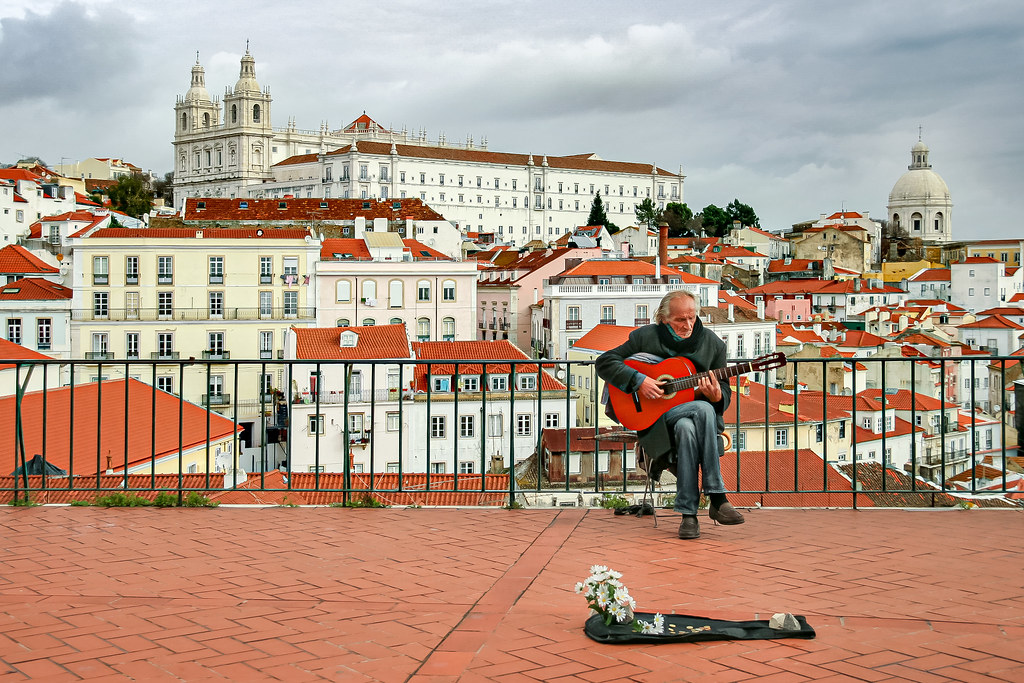
Alfama is the oldest and most photogenic community in Lisbon.
The district has cobblestone streets and multiple scenic viewpoints, giving a bird’s-eye view of classic red roofs, cathedrals, and the Tagus River.
Within Alfama, you will find iconic historic buildings, including the Se Cathedral, Castelo de Sao Jorge, Igreja de Santo Antonio, and the Panteao Nacional.
Historically, the district was outside the castle walls and home to the poorer residents of Lisbon. As Lisbon became a maritime city, it became the home to dock workers and sailors.
Today, Alfama is a fashionable and artisan district with a rich history and unique character.
The Easy Lisbon Quiz
Ready to test your Lisbon knowledge?
I’ve made an easy Lisbon quiz with 5 questions. Let’s see if you can get them right. 🤞
Getting to Alfama Lisbon From The City Center
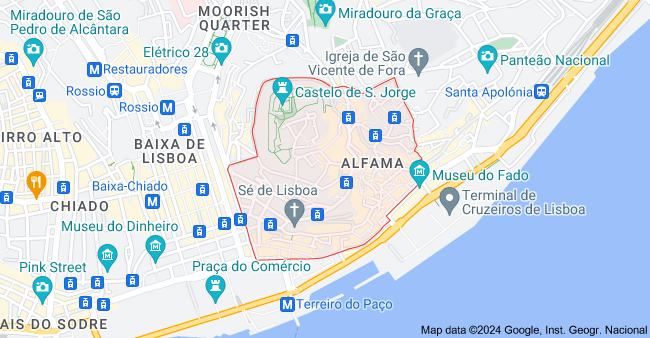
If you stay in the city center, you will not need to travel far to reach Alfama to enjoy the community atmosphere. Your trip should take 5 to 20 minutes. You can get to Alama by public transportation using the tram or bus.
Tram Route
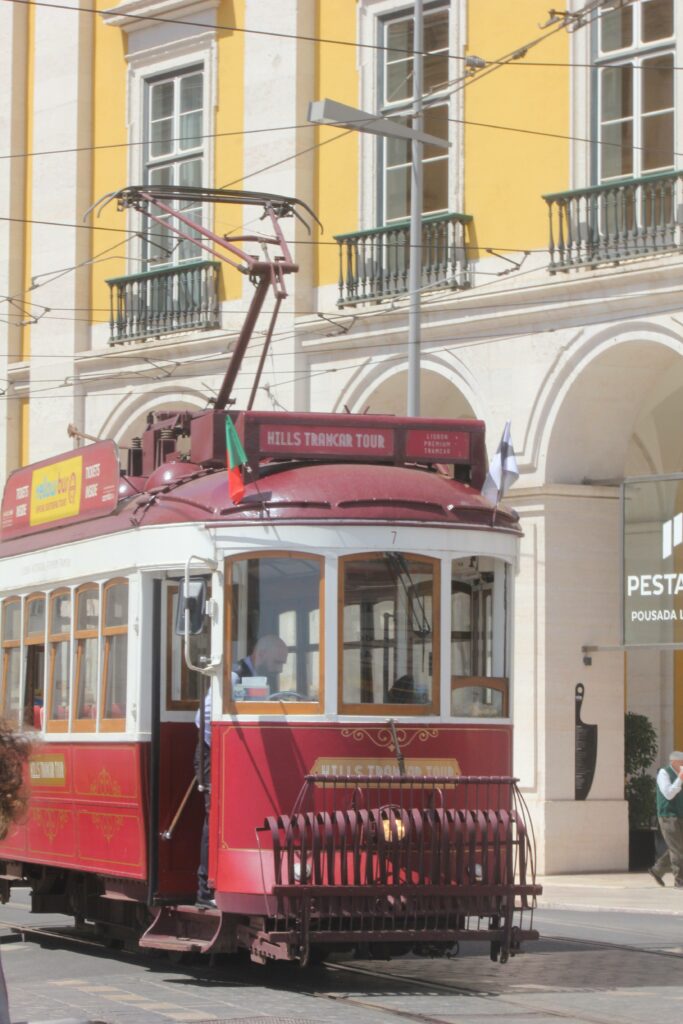
I suggest commencing your exploration of Alfama from the farthest viewpoint from the river, Miradouro da Graça.
You can easily reach it within 20 minutes by taking the vintage Tram 28E from Praça do Comércio.
The tram is not only a convenient mode of transportation, but the tram route also offers a delightful way to visit the castle and various cathedrals in Alfama.
Hot Tip🔥: Invest in the Lisboa card as public transport is included.
By Bus
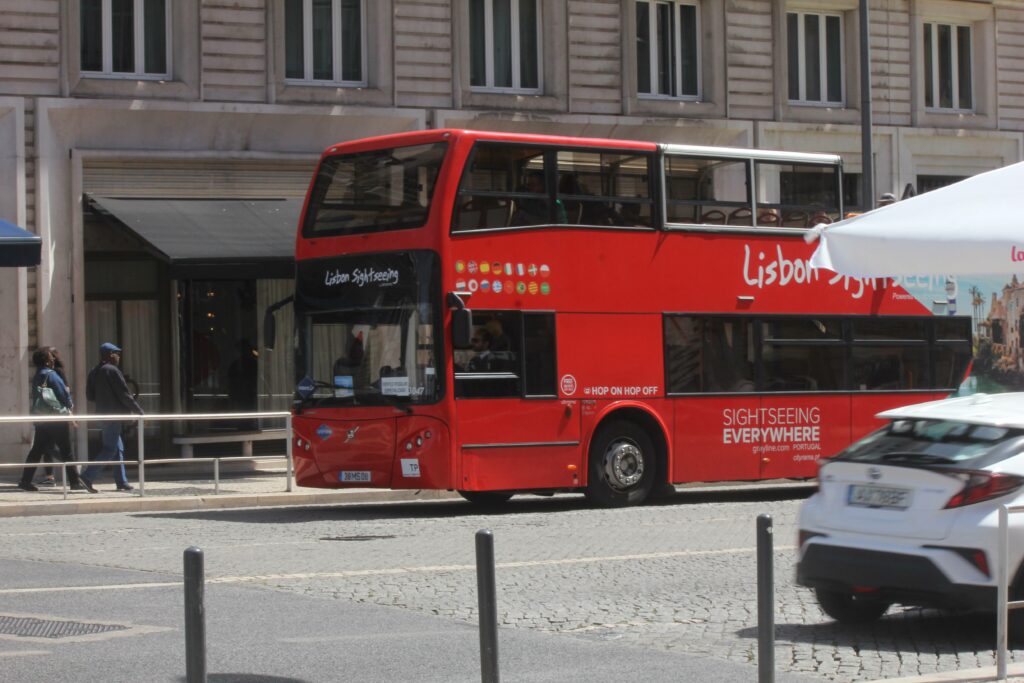
Another option is to get on the hop-on-hop-off bus, which includes Alfama and has several stops, such as Lisbon Cathedral, Saint Anthony Church, and Lisbon Castle.
16 Things to Do in Alfama Lisbon
Miradouro da Graça Viewpoint

If you are looking for a fantastic vantage point from which to view the city, I highly recommend visiting Miraduoro da Graça.
The terrace is a well-known destination. It boasts a few trees that provide shade and an open-air café perfect for taking a break and resting your feet.
Situated on a hill above one of Lisbon’s oldest Baroque churches, the terrace offers stunning views of central Lisbon, the castle, and the river.
Getting there is simple – you can either walk or take Tram 28E.
Campo de Santa Clara
Santa Clara Square is a charming location encircled by stunning architectural masterpieces, comprising two churches.
If you visit on a Tuesday or Saturday, you can experience the renowned pop-up flea market called “Feira da Ladra,” which has earned the nickname “Thief’s Market.”
For those weary from walking around, the square offers a small garden in the center where you can sit back and catch your breath.
São Vicente of Fora Church
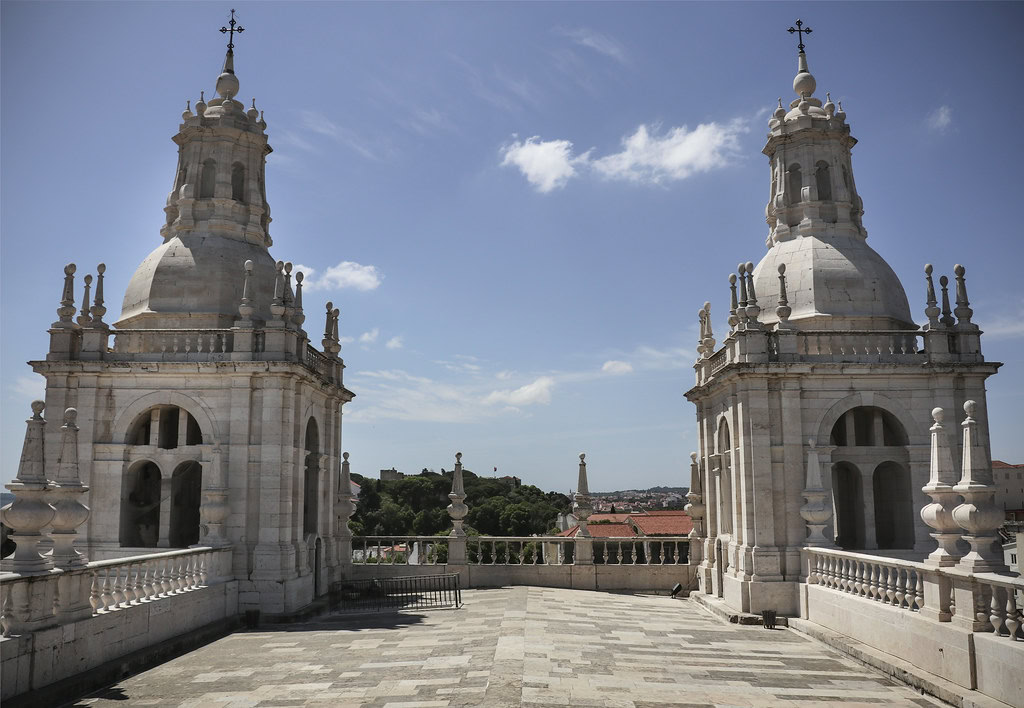
Hours from Mondays – Saturdays: 9:00 am – 20:00
Hours on Sundays: from 9:00 am – 12:30 pm and 15:00 – 17:00
Adult – 5 €
Senior – 2,50 €
Student – 2,50 €
Children Free until (age) – 12
The church is situated on the same hill at a lower height than the Miraduoro.
It was constructed in 1582 at the identical location where the old church monuments of the battlefield stood.
The monument was built to commemorate the Portuguese and European crusaders buried there.
Amália Rodrigues Mural
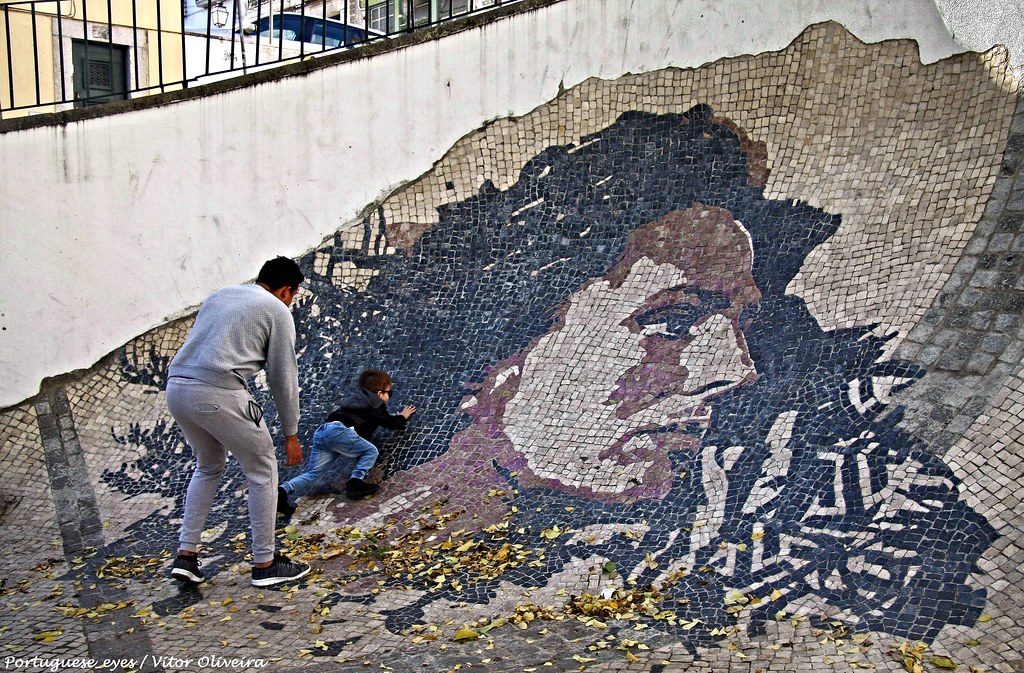
The mural featuring Amália Rodrigues is a renowned street art piece in Lisbon.
Amália Rodrigues, also called the Queen of Fado, was a celebrated Portuguese actress and singer who played a key role in popularizing fado worldwide.
The mural is a mosaic that extends up onto a wall, seamlessly blending into the cobbled street below. Interestingly, thanks to the ingenious arrangement of the mosaic pieces, Amália appears to cry when viewed in the rain.
If you look closely, you’ll see other murals of the singer scattered around Lisbon.
Hot Tip🔥: Explore the street art around Alfama and other districts in Lisbon.
National Pantheon
Hours: Tuesdays – Sundays from 10:00 am – 18:00
Closed: January 1, Easter Sunday, May 1, and Christmas Day
The National Pantheon is a stunning example of Baroque architecture influenced by Italian Renaissance design.
The walls feature colorful marble and flowing shapes, and the central nave leads to several tomb rooms that honor national figures such as explorer Vasco de Gama and Fado legend Amelia Rodriguez.
The terrace offers another breathtaking view of Lisbon. This beautiful monument is the resting place for many writers, artists, former presidents, and military figures.
Hot Tip🔥: Use the Lisbon Card to get admission free.
Museum of Decorative Arts
Hours: Wednesdays – Mondays from 10:00 am to 17:00
Closed: January 1, May 1, and Christmas Day
Price: €4 per adult pay €3.20 using the Lisboa Card
The Museum of Decorative Arts exhibits the opulent Portuguese interior design and art style from the 17th and 18th centuries.
Visitors can witness a stunning array of colors and designs inside the palace. The preserved furniture, china, table settings, framed artwork, and paintings are just a few treasures in the museum.
The museum also houses carriages, tapestries, and furniture from other parts of the world.
Worthy Note 🗒: You cannot take bags or large backpacks inside. Also, check out some of these free museums in Lisbon.
St. George’s Castle
Hours November – February: from 9:00 am – 18:00
Hours March – October: from 9:00 am – 21:00
Price: €10 adult / €5 student / FREE under 12
The castle’s origins can be traced back to the Roman era, around 200 BC. Over the centuries, it was fortified, conquered, and occupied by various groups, including the Moors and Crusaders.
However, the castle suffered significant damage due to an earthquake in the mid-1700s, and it was later restored in 1944, marking the last major renovation.
The castle is regarded as one of the city’s most important landmarks, given its rich history and cultural significance.
Hot Tip🔥: Travel with the Tram 28E included in your Lisboa Card.
Visit a Viewpoint: Miraduoro das Portas do Sol
Nestled atop the hill in Alfama, the city boasts several excellent vantage points.
Miraduoro das Portas do Sol presents a stunning panorama of the Tagus River and the city’s red rooftops.
You can even glimpse the hills and mountains beyond the water on a clear day. As you stand on the terrace, you’ll also see the São Vicente of Fora Monastery in the distance.
Igreja de São Miguel
Saturday Mass: 17:00
Thursday Mass: 18:00 (Only between mid-September and mid-June.)
The Catholic Church has been an integral part of the community in Alfama since the neighborhood was established.
However, the church was rebuilt entirely before the mid-1700s. The nave’s interior is intricately adorned, making it a must-visit attraction for anyone interested in religious architecture.
Although all services are conducted in Portuguese, attending mass provides an opportunity to listen to the choir and immerse oneself in the local community ambiance.
Miraduoro de Santa Luzia
For more outstanding city views, visit Mirador de Santa Luzia. Here, you can witness the beautiful architecture of Alfama as it slopes down towards the Tagus River.
The deck is covered with trellis supporting vines, surrounded by decorative tiles and a small garden. From this point, you can spot the domes and towers of nearby churches.
Lisbon Cathedral (Sé Cathedral)
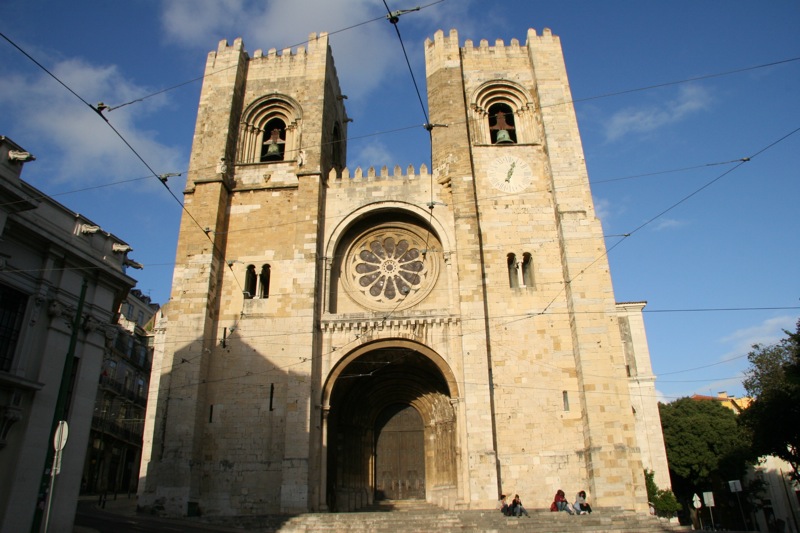
Hours: Daily from 9:00 am – 19:00
Mass Times: Sundays at 11:30 am and 19:00, Tuesdays and Saturdays at 18:30
The Sé Cathedral, the Cathedral of Saint Mary Major, is Lisbon’s oldest church.
Constructed in 1147, it underwent several renovations and modifications due to natural disasters like earthquakes, fire, and the passing of time.
The cathedral boasts an awe-inspiring mix of Gothic, Romanesque, and Baroque architecture and remarkable artwork.
One can find sculptures resting on tombs, intricate windows, exquisite embellishments, and paintings that add to the church’s beauty.
Museum of Lisbon
Hours: Tuesdays – Sundays from 10:00 am – 18:00
Tours: Tuesdays and Thursdays at 15:00, English and Spanish
Price: €3 per adult, free for children anytime, and free for everyone on Sundays before 14:00
The Museum of Lisbon is housed in a former leather bag factory and printing press building.
Located near an archeological dig site, it showcases artifacts and information about the ancient Roman Theatre in Lisbon.
Visitors can see excavated ruins, 3D models, and videos of the structure’s appearance and functionality during its use.
It is a must-visit destination for history and archeology enthusiasts.
Igreja de Santo António de Lisboa Church
Hours: Saturdays and Sundays: from 8:00 am – 20:00, Mondays – Fridays from 8:00 am – 19:00
Mass on Saturdays and Sundays: at 11:00 am, 17:00, 19:00,
Mass from Mondays – Fridays: at 11:00 am and 17:00
In the mid-1700s, a Catholic church was constructed on the site where experts believe Saint Anthony was born.
The church’s exterior is stunningly vibrant, complemented by lofty vaulted ceilings and a dome allowing ample natural light.
The Church of Saint Anthony of Lisbon has been reconstructed several times since its original 15th-century inception and now stands as a national monument.
Additionally, a saint statue is in the square before the church, which Pope John Paul II sanctified in 1982.
The church’s crypt is built where Saint Anthony’s birthplace once stood. Visitors can also observe a canvas that showcases the most accurate facial representation of Saint Anthony.
If you’re in Lisbon on June 13, you can participate in the yearly procession at the church, which winds through Alfama in honor of Saint Anthony’s “patron saint day.”
Museum of Resistance and Liberation (Cadeia do Aljube)
Explore the rich history of Portugal at a museum that also served as a former prison, shedding light on the struggle against dictatorship and the eventual liberation of the country.
The Museum of Resistance and Liberation, situated close to the Se Cathedral, boasts a permanent exhibit and rotating temporary exhibits that change every few months, providing visitors with a fresh experience each time.
While adult admission requires a ticket, the cost is reasonable. Discounts are available for adults aged 13-25 and seniors over 65. Children 12 years and younger can enter for free.
Lisbon Army Museum
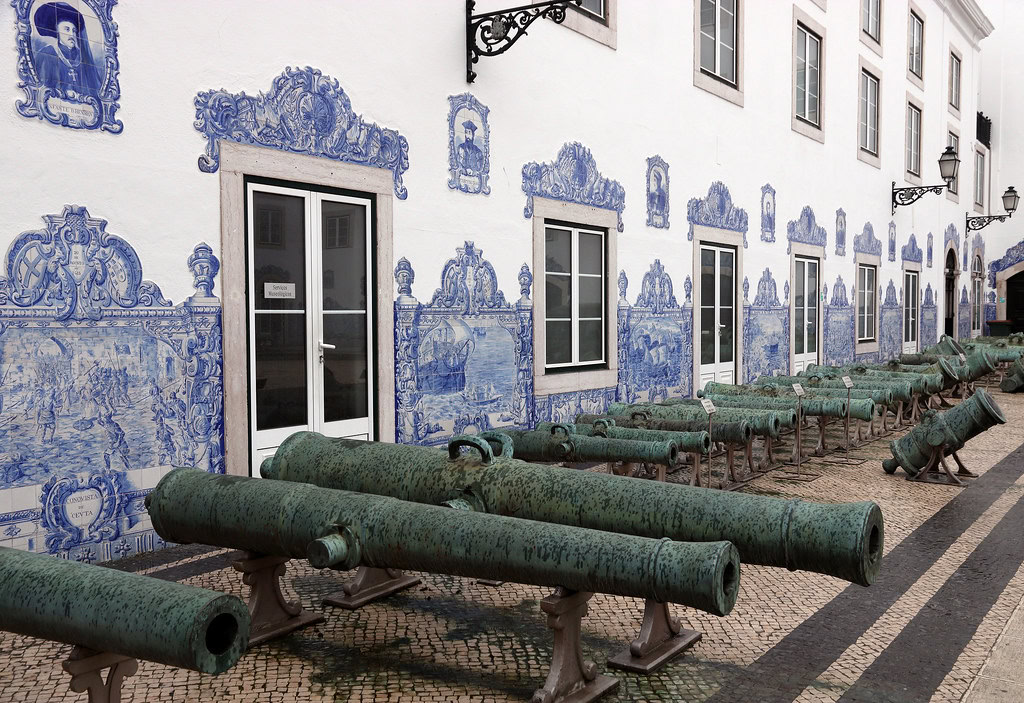
Hours: Tuesdays – Sundays from 10:00 am – 17:00
Price: €3 adult / €1 senior or child also receive 20% using your Lisboa Card
The Museu Militar de Lisboa, located on the site of a former 16th-century shipyard, boasts the world’s most extensive collection of artillery.
The museum provides a comprehensive overview of Portugal’s rich military history through various exhibits, including illustrated tiles, paintings, documents, and gear.
Visitors can explore various subjects, such as World War I, Vasco da Gama’s discovery of his route to India, and the Peninsular War.
In addition to its fascinating exhibits, the museum building is also a point of interest, as it is an excellent example of the lavish Baroque style.
Museum of Fado
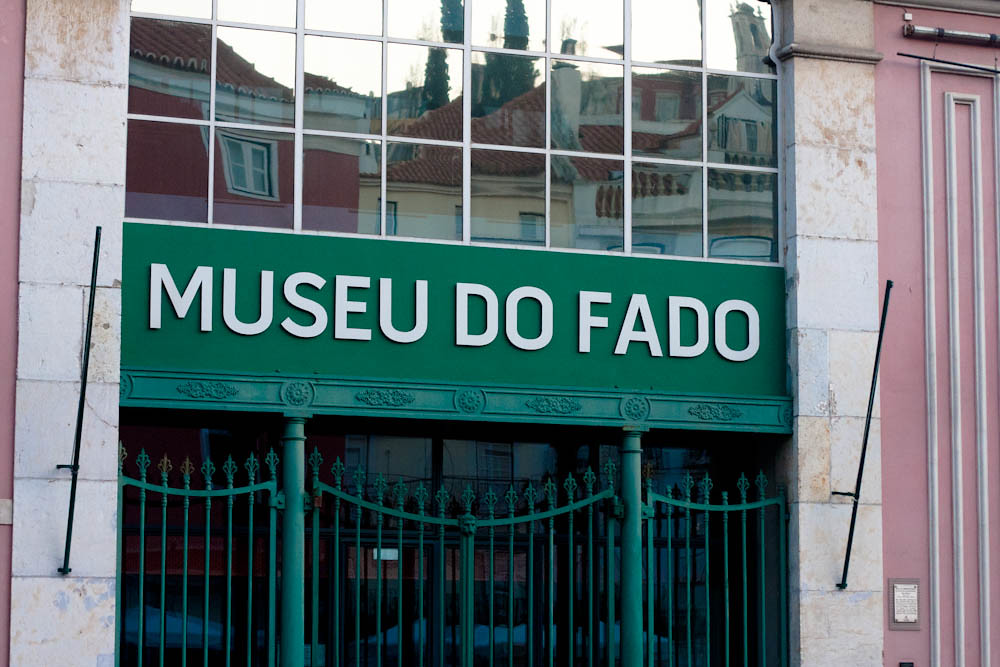
Hours: Tuesdays – Sundays from 10:00 – 18:00, Final Admission at 17:30
Closed: January 1, May 1, and Christmas Day
Price: €5 adult / €2.50 young adult 13 – 25 / FREE under 12
Paid Tours: €3 per 1-hour tour (Book in Advance)
The Museu do Fado is a tribute to Portugal’s talented fado musicians and singers, who have shaped Lisbon’s culture with their emotional and somber genre.
Although fado’s roots can be traced back to ancient times, it became popular in Lisbon in the early 1800s. Today, you can often hear fado in Portuguese pubs and restaurants, where the melancholy lyrics revolve around themes of fate, longing, and the sea.
The museum houses a remarkable collection of instruments, especially guitars used for fado, and artwork that showcases the genre’s influence on Lisbon’s culture.
To help visitors appreciate this mournful genre, the museum offers interactive exhibits, audio guides, and live performances at the attached restaurant.
If you wish to explore the museum in-depth, you can pre-book a guided visit in Portuguese, Spanish, English, or French by emailing the museum.
Planning On Going To Lisbon?
I’ve created a trip planner where you enter the number of days you’re going and what activities you want to do.
Based on your input, you then get an entire vacation planned with ideas.

Alfama’s Challenges While Exploring
When exploring Alfama, you first notice the steep hills that rise from the banks, starting at Tejo Estuary and going to the castle. Then, there is a second hill leading up to Graca.
Hence, you have very few flat areas, meaning you will climb steep pathways and staircases. Thus, visiting the Aflama district, especially in summer, becomes very demanding.
Hot Tip🔥: To help reduce walking uphill time, I recommend you take the number 28 or 12 tram to Largo da Graca and then walk downhill throughout the district. Also, to prevent getting lost, always move downhill as it leads to the Tejo waterfront.
Cost of Day Trips to Alfama

You need not pay a fortune for a day trip to Alfama if you enter many free buildings like churches and viewpoints. Entrance fees to some of the places cost:
- Tram 28: €3
- Lisbon Caste: €10
- Se Cathedral is free
- Se Cloisters and the treasury: €3
- Museu de Santo Antonio: €3
- Roman Amphitheatre is free
- National Pantheon costs €4
- Fado Museum: €5
- A Metro single ticket costs €1.80
Staying in Memmo Alfama
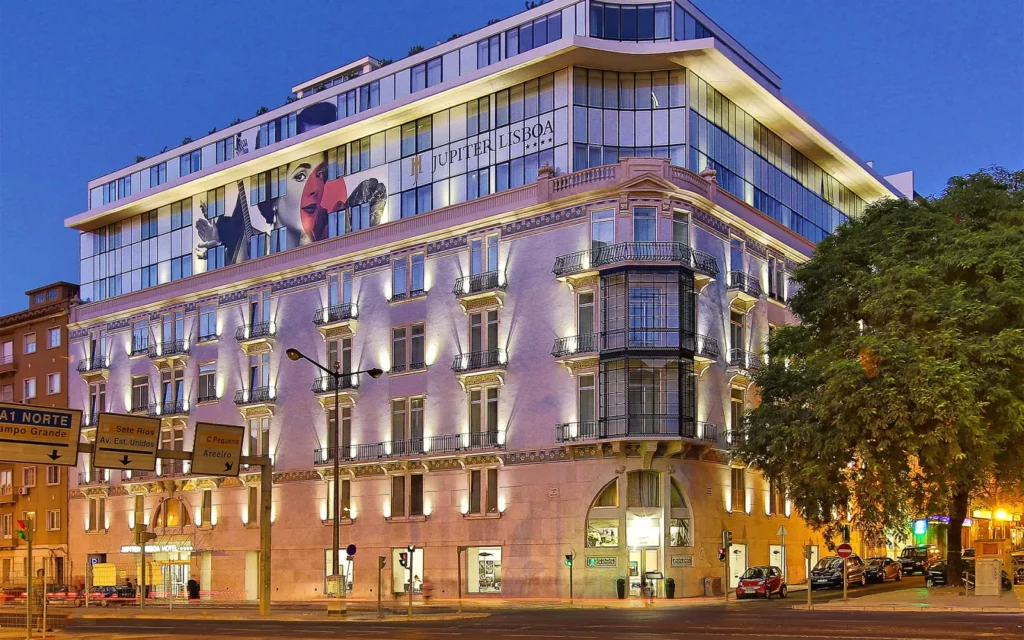
Alfama is one of the most popular Lisbon neighborhoods to stay in. Here, some traditional homes are converted into rental apartments or small hotels.
Hot Tip🔥: Check out some of my favorite hotels in Alfama to stay when visiting.
The best part of staying in the neighborhood is that the leading tourist destination is within walking distance of the Bairro Alto and Baixa districts.
Here are the best things to do in Lisbon In July 2024
I’ll send you a list of the best things to do in July and every month moving forward from today.
It’ll be based on my personal experience of living and traveling around Lisbon. A lot of hidden gems.
Nightlife in Alfama
Alfama’s nightlife has a unique charm that sets it apart from other districts in Lisbon. While it may not be as bustling and vibrant as areas like Bairro Alto or Cais do Sodré, it offers a more laid-back and intimate nocturnal experience.
- Fado Houses: Alfama is famous for its traditional music and scattered houses. You can enjoy soulful performances with Portuguese cuisine in a cozy and intimate atmosphere.
- Cafes and Bars: Alfama’s cafes and bars are charming and have outdoor seating. You can enjoy mild evenings mingling with locals over drinks and snacks.
- Night Strolls: Alfama’s nightlife offers peaceful nighttime strolls on its narrow, cobblestone streets. The district is perfect for a leisurely walk, taking in the historic architecture and serene beauty of the surroundings—charming spots off the beaten path where you can enjoy a more secluded and intimate nightlife experience.
How Safe is Alfama
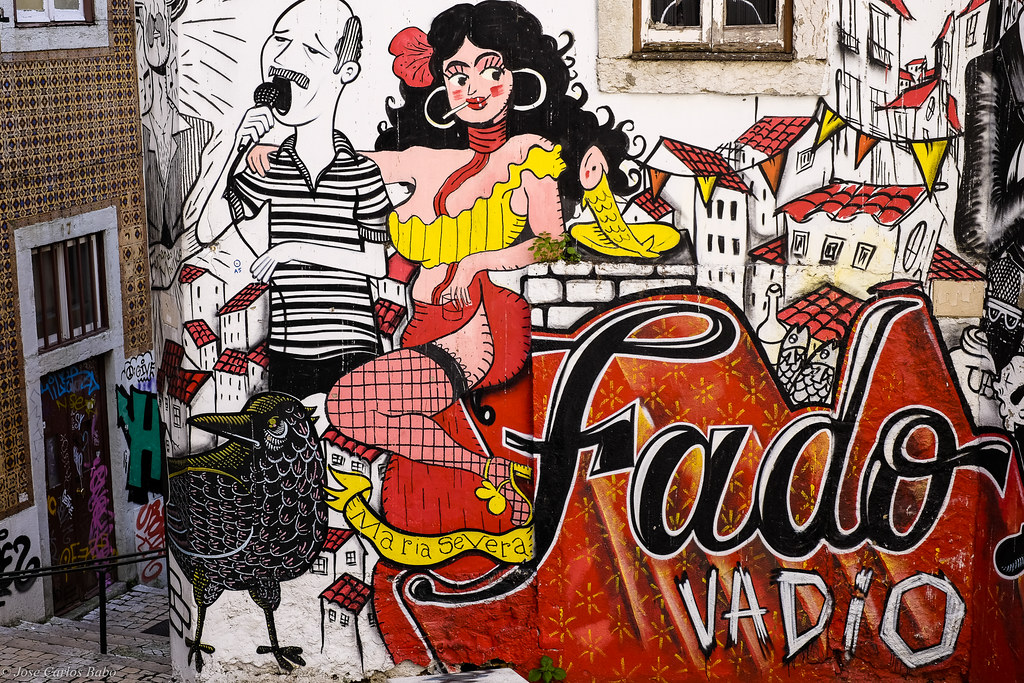
Alfama is generally considered a safe neighborhood in Lisbon, particularly for tourists. Its popularity as a historic and cultural destination attracts visitors worldwide.
The district enjoys a higher police presence due to its tourist appeal, contributing to overall safety. Yet, like any urban area, it’s advisable to stay vigilant against pickpocketing, especially in crowded spaces or during events.
Alfama’s charming streets and vibrant community create a unique atmosphere; standard precautions should be taken while enjoying the nightlife.
Hot Tip🔥: Before planning a trip to stay in the district, read my complete guide about a free walking tour of Alfama.
The Advanced Lisbon Quiz
You’re now at the advanced Lisbon quiz with more difficult questions. No one gets every question right, so don’t beat yourself up on it. Good luck.
Wrap-Up: Alfama Lisbon
Alfama is a captivating and historically rich neighborhood in Lisbon. It offers historic landmarks, charming narrow streets, and breathtaking panoramic views.
While its nightlife may be quieter, it presents a laid-back and intimate atmosphere perfect for strolls and enjoying traditional Fado performances. Explore Alfama and immerse yourself in its unique ambiance.
